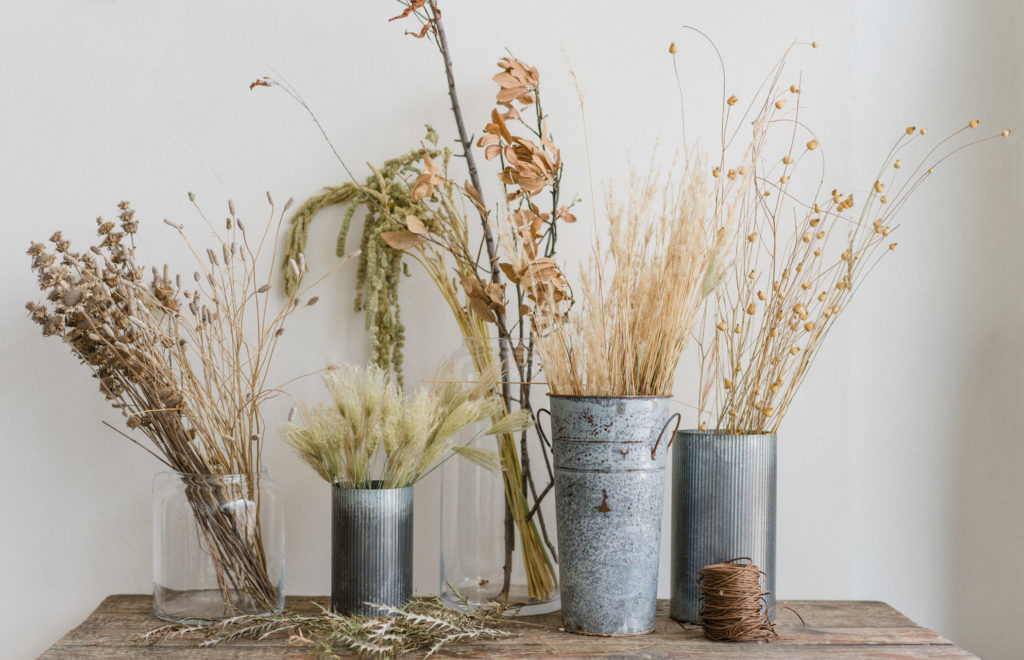With cool and crisp weather on the horizon, we’re always searching for new and creative ways to bring fall foliage inside. Placing fall floral stemsOpens in new tab in a vase is a simple and effective way to do this, but today we’re kicking things up a notch with wreaths! Making a homemade wreath is another unique way to incorporate a variety of floral colors and textures—some of which you can easily forage from your own backyard. Below, we’re walking you through how to make your own dried floral wreath.

WHAT YOU'LL NEED
Tools
+ Gardening ScissorsOpens in new tab or Pruning ShearsOpens in new tab
+ Bind wire—brown, kraft paper-covered wire (it’s bendable and blends with the florals we used)
+ Pliers
+ Grapevine wreath—you can find these at your local craft store. Set aside until step 3.
Florals
**Forage for dried florals
**Start by looking around where you live—In your backyard, near a river or lake
If there's not a lot to forage in your area, these websites offer dried florals for purchase:
afloral.com
bloomist.com
nettletonhollow.com
etsy.com (search for dried grasses or dried branches)
**Buy or forage fresh florals and dry yourself
**Keep in mind that if you’re drying fresh florals, they take 3-7 days to dry. The best way to dry is in a dark, dry area, secure the bottom of the stem(s) with string and hang them upside down.
Florals We Used
+ 12-inch Grapevine wreath (purchased at a local craft store). You can also create one yourself by foraging vines and tying them together in a circular shape.
+ Dried flax (purchased at craft store)
+ Illinois bundleflower (foraged)
+ Grevillea (purchased from florist and dried)
+ Fescue grass (foraged)
+ Live oak (foraged)
+ Oat grass (foraged)
+ Switchgrass (foraged)
+ Green ash (foraged)
+ Pampas grass (purchased and dried)
+ Horsemint (foraged)
STEPS
1.
Make 3-5 Small Floral Bundles
Use 5-6 dried floral elements in each bundle of different varieties and sizes. (Don’t use any long and wispy branches (like green ash) until step 3.) Tie them together with a small piece of bind wire. Wrap the wire completely around bundle until it is secure. This step is important because it will help you piece your wreath together and fill it out later!
Florals we used in this bundle: dried flax, Illinois bundleflower, grevillea, fescue grass and live oak
2.
Lay Out Bundles in the Shape of the Wreath
Before you grab the grapevine wreath, first lay out 4-5 bundles (we used 4) in the shape of the wreath to get an idea of the shape and movement you want. As you arrange the floral bundles in that shape, some pieces may break off—you can reattach them later. Set the bundles aside, but keep them in the shape you created in this step.
3.
Attach Wispy Branches to Grapevine Wreath
Bring the grapevine base into your workspace. Attach long, wispy branches to the wreath and secure them in place by tying a small piece of bind wire to attach it to the branch.
Florals we used in this step: green ash
4.
Attach Bundles to Wreath
Attach the bundles you set aside in step 2 to the grapevine wreath and secure them with bind wire. You can use more bundles (or less) depending on the size of your wreath.
5.
Fill in with More Color + Texture
Have fun with this step—this is where you make the wreath look fuller! Attach branches and leaves that add more color.
Florals we used in this step: live oak
6.
Add Whimsy
Here you’ll add the final textural elements to your wreath. Take time on this step, and add what you think the wreath needs to complete it. We added most of these elements in the bottom left section of the wreath. Fluff florals that have may have been flattened in the wreath-making process.
Florals we used in this step: pampas grass, horsemint
7.
Make Edits to Your Wreath
Hang the wreath on a blank wall, then step back and evaluate. Is there anything that needs to be added or taken away? If so, go back to step 6 and add or remove elements.
Enjoy your new wreath this fall and the fall seasons to come! (Look below for instructions on how to preserve it for next year.)
Wreath Preserving Tips
Lay the wreath on a large piece of cardboard and spray both sides of the wreath with a foliage sealant (this helps dried leaves be more stable and resist shattering). Store in a flat box with a lid until next season!